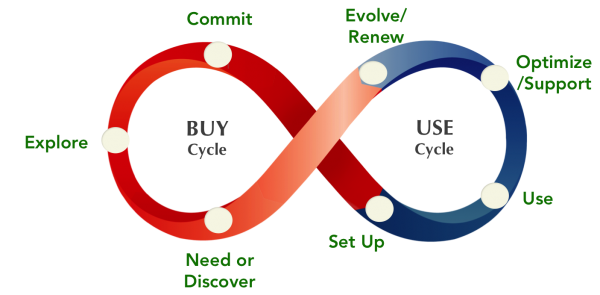As many software companies move their products to cloud-based offerings, the question comes up: where is the difference between supporting cloud-based products and supporting on-premise products? Talking to customers and partners over the last couple of months I’ve made some notices which I want to share with you.
While support still consists of answering questions and solving problems for customers, the nature of those questions change in two ways. First, support topics shift from supporting product functionality to supporting customers with their business processes. This requires support agents to develop a higher-level understanding of what their customers are trying to accomplish with the functionality or services purchased. Support staff needs to have a better sense of the context of use and an understanding of the customer’s business. We call this set of abilities found in a single person to be T-shaped. „The vertical bar on the T represents the depth of related skills and expertise in a single field, whereas the horizontal bar is the ability to collaborate across disciplines with experts in other areas and to apply knowledge in areas of expertise other than one’s own.“¹ With cloud-based products, customer communities and social networks can be valuable for both customers and support staff as a way to leverage customer experience.
Second, the restoration of service becomes a key issue. The company, namely the support organization, is now responsible for the systems the functions operate on and, in part, the network to access those systems. This means a significant shift of responsibility from the operations team of the customer to the operations / support team of the company. Or, like the service manager of a large service provider stated to me: “If you are going to insource operations from your customer you need to have flawless processes yourself.“ Support teams need to have a heightened sense of awareness of the system dependencies and be able to quickly identify and resolve issues in the infrastructure that are impacting response times or availability.
In his four commandments for trusted internet services², Open-Xchange’s CEO Rafael Laguna lists these requirements:
-
- A Service you use must be available from many providers
- It must be possible to move your data from one to the other
- The Service must (also) be available as Software
- The Software should be available in Source Code to everyone
Taking this serious means you decide for a solution that is available both as cloud service as well as locally installable software. The relative ease of switching between different cloud-based products and between cloud based and on-premise products requires an increased awareness of the customer experience at every touchpoint (see image Generic Touchpoint Model³). This is critical as the renewal and/or retention process in a cloud-based offering occurs in hours and days, not the months and years of on-premise software and hardware. Here again, a lot can be learned in real time about customers’ attitude and intent through a community and social media monitoring system.
With cloud-based offerings, the vendor has the opportunity to help customers to be more productive and make full use of the product functionality. This goes along the line what TSIA says about adoption of value respectively the consumption gap if adoption does not (fully) happen⁴. Because the vendor has visibility to very detailed information about the customer behavior – the clickstream, navigation, and functions being used – there is an opportunity to inform customers of more productive ways to use the product and about functionality that they are not using but might find helpful. Salesforce.com has a pretty sophisticated process by which they make this information available to customers through both automation and Customer Success Managers.
Introducing cloud-based products does have an impact on support. There is a need to broaden the scope of support knowledge to include business acumen and system operations capabilities. The ability to make knowledge available quickly to both workforce and customers becomes an essential asset of the support organization. The same applies for searchability and more important findability of knowledge in order to enhance the customer’s ability for self-service. Even more important, there is an opportunity to learn more about who your customers are and how they use your products and provide them with “unsolicited, best use” information.
Links:
[1] https://en.wikipedia.org/wiki/T-shaped_skills
[2] http://www.whd.global/downloads/2015-global/mFtag1d.pdf
[3] http://www.serviceinnovation.org/
[4] https://www.tsia.com/documents/Closing_the_Consumption_Gap/

